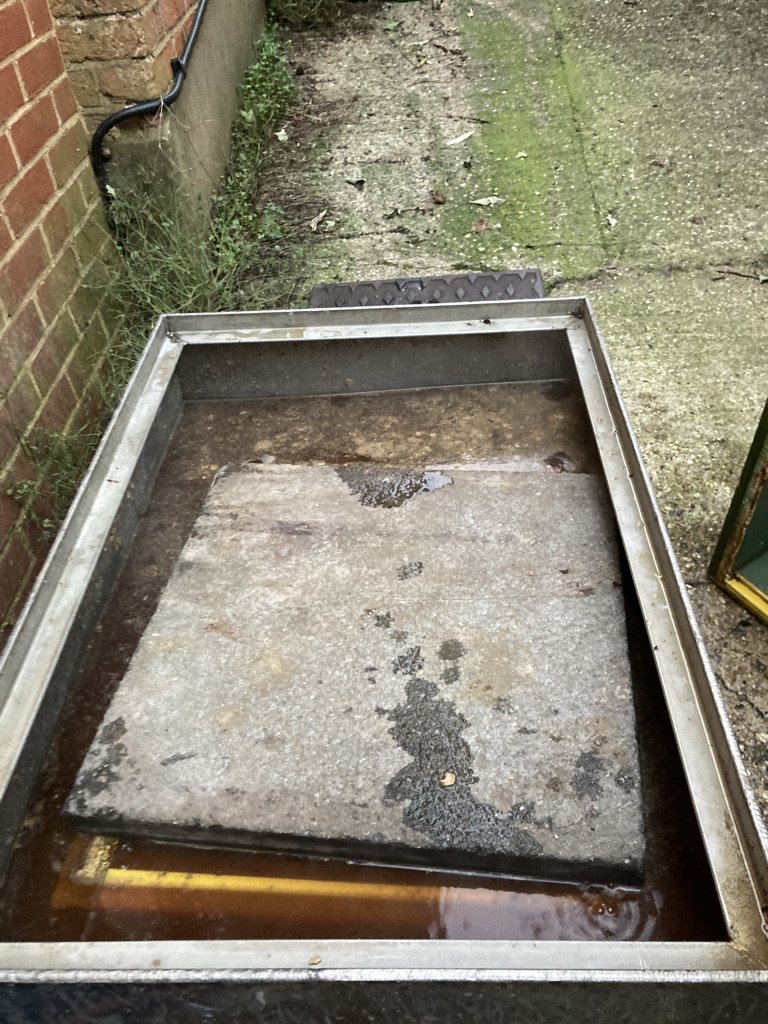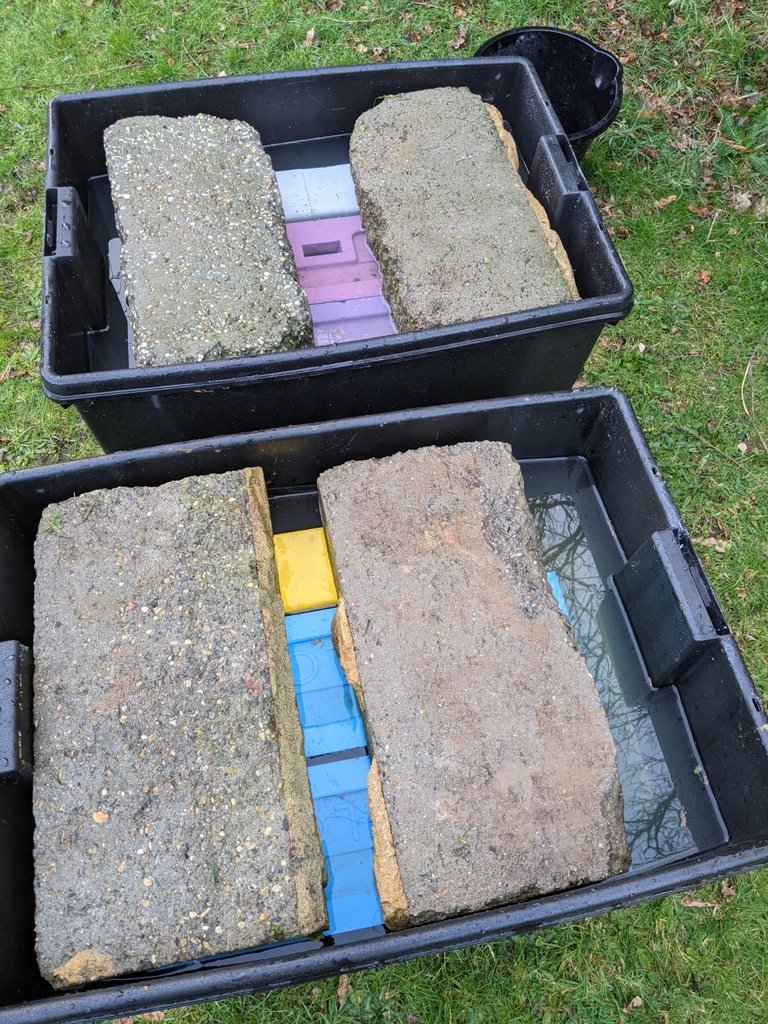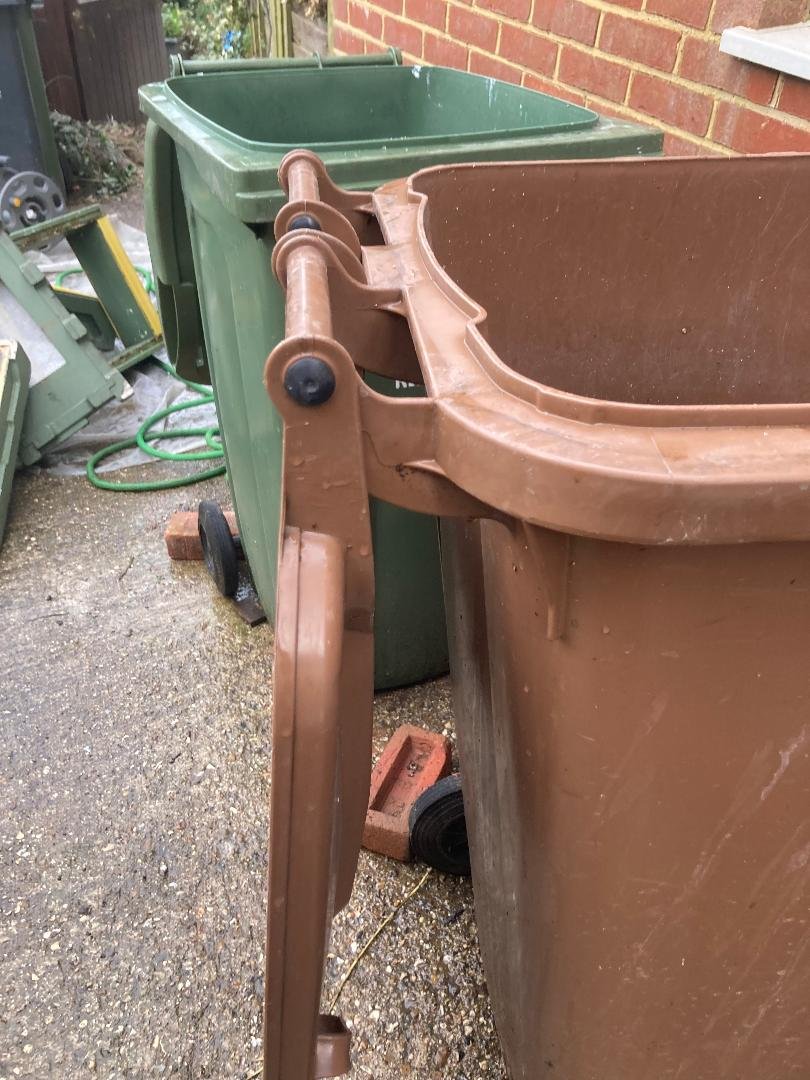
Cleaning Poly hives
Easy and time consuming
Basic Assessment: describe the procedures for cleaning poly and wooden hives.
Cleaning
Best employ a washer person
Scraping
The picture shows damage from scraping. Other poly hives are made from EPS 160 kg/m3 and at this density scraping is safer. Hives are best scraped in cold weather when wax and propolis are brittle.
It is often banded about that poly hives should be scraped. No, No, No! Never be tempted to scrape a BeeBox hive. Leave your scraper in your shed; Sometimes, you have to scrape the wax off the inner surface under a feeder, and I guarantee you will cause damage. If needs be, use a blunt implement almost pushed parallel to the surface. If this fails, try a hive tool or a wide chisel.
Steaming
Wax and propolis softened by steam are easily wiped off. You’ll need a good supply of rags. The technique of using steam from a wall-paper stripper is essential. Angle the steam jet obliquely, just a few degrees from the horizontal. This makes cleaning quicker and will suffice if you only have a couple of hives. More rigorous cleaning is required before repainting.
Some people put the boxes, one by one, into a steam box so that the gunk runs off. A steam box like this is more frequently used to extract wax from wooden frames.
Soaking
Beeswax is rich in esters and fatty acids, which, when mixed with an alkali, results in some form of alcohol (not whisky) and soap, which can be sloshed down the drain.
Washing soda (sodium carbonate) is moderately effective as a cold solution (It is so ls slow that in desperation I add other household chemicals). A hot solution works wonderfully.
Its solubility in water varies with temperature by percentage weight: 12% at 10 degrees C. and 17% at 20 °C, maximal solubility is 35.4% at 33.2 °C.
Use a mixture of 1 kg of washing soda mixed with 5 litres of water, i.e. a 16% solution by weight.
The Chemistry of Washing soda — Sodium carbonate
Sodium carbonate Ca2CO3 should not be confused with sodium bicarbonate NaCO3. When Sodium Carbonate dissolves in water, it forms a weak acid, Sodium carbonate and a strong base (alkali), Sodium hydroxide.
Na2CO3 + H2O = NaOH + H2CO3
Hot Soaking
Hot soaking is easy. Just like washing the dishes. It takes four minutes per box. To achieve this, I add 6 – 8 kg of washing soda depending on how much I need to clean -(I’ve comfortably cleaned 18 boxes with 6 kg) to a 76-litre tank and heat it to just up to 50 ºC. In the picture, the sponges (pieces of pipe insulation) on the edges of the tank are to reduce damage to the boxes. However, since I took this picture, I have changed my technique so they are less necessary.
My tank has a lip that supports the lid. This means that hive parts can be floated and held underneath it without knocking into the tank edges.
Thermal gloves could make soaking possible. I’ve not tried these. There are extremely expensive alternatives.
It isn’t easy to find a cheap metal container for hot soaking. Finding a tank large enough for a National will take some research. Perhaps a second-hand pot wash sink or steel drum could be adapted.
Hot wiping
The benefit of a short hot soak occurs when the item is brushed underwater. Less than 50 °C is sufficient. Without proper gloves, one’s fingers feel the heat. The alternative is to slosh some hot solution on the place to be cleaned using a brush, like a washing up brush. Dip the brush in the hot solution, brush lightly, put the brush back in the solution and repeat, i.e. With the same motion as wet shaving. It works well, only a bit slower than soaking. In this way, you don’t need a large tank.
Hot soaking workflow
Remove wax in the tank of hot water (the tank is just visible as a bit of grey in the picture). I use a washing-up brush; it is ruined by a single cleaning session.
Rinse in a water butt.
Clean with a soft pressure hose brush or similar.
Leave to dry
An optional stage is to remove excess wax with steam before stage one.
-

Use 4 - 8 Kg of washing soda
-

Mucky edge before cleaning
-

Damage caused by cleaning the box whilst it was immersed
-

After cleaning
-

Deposits of washing soda from previous cleaning
-

Paving stone weighing down a Beebox
Cold Soaking
Adding a large dollop of bleach and washing up liquid isn’t a bad idea; I don’t suppose it is evidence-based; even so, I believe it makes a difference. A YouTube guy says as little as 1.5 kg of washing soda per 100 litres has an effect. Yes, little effect.
It takes some detective work to find a suitable container for soaking. The top part of a large wheelie bin is big enough, but you’ll need to make a lot of solution. Some Wham Bam boxes are suitable (2024). 3JC Ltd gives the inside proportions. Alternatively, look for a pre-formed fishpond or a domestic cold water tank.
To make cleaning easy, a person on YouTube recommends submerging parts for a fortnight. After this, the solution smells unpleasant. Since most of the effect takes place in the first 24 hours, I do that. Cold soaking works well, but does make cleaning a protracted affair. Some people do a perfunctory dip and scrub and claim positive results. I wonder how. Possibly, soaking for twenty minutes to one hour may be sufficient.
Cleaning Wooden Hives
Scrape to remove crud and wax: best done in freezing weather.
Flame using a gas wand. Flaming disinfects, although without severe scorching, it cannot sterilise wood. Wood is porous, and bugs live in it to a depth of several millimetres. The advice is to heat the boxes inside until the surface looks chestnut brown. After scorching the surface a few times, the wood is permanently chestnut brown. Occasionally, consider doing minimal cleaning: Scorch the runners, wait for cold weather and scrape the insides.
Removing wax, and crud using a hive tool. This is best done in cold weather.
Flaming a box with a gas torch. The interior and dummy board eventually go black.
Chemicals for cleaning, disinfection and fumigation
Washing soda – see above
Acetic acid kills Nosema and wax moths and other nasties
Hypochlorous acid (HClO)
Sodium hydroxide (Lye) – very corrosive, not suited for use by hobbyists
White spirit - No!! Ignoramous beekeepers occasionally mention this.
Sodium Hypochlorite (Bleach, NaHCl). Views vary regarding whether it becomes less potent despite being stored in a sealed container. In a health care setting it becomes weaker, whereas as a swimming pool treatment it does n’t. Since EPS is slightly porous, it cannot be chemically sterilised. Bleach attacks metal, so slather metal runners with petroleum jelly. You must never mix Hypochlorite with an acid. I did it out of curiosity and can testify that chlorine gas is pungent and green.
Spraying bleach: after cleaning, destroy yeast by spraying the surfaces with bleach. Avoid inhaling the spray and protect your eyes. The recommended strength for general disinfection in healthcare is a concentration of 1,000 ppm of sodium hypochlorite. This involves putting 50ml of household bleach in one litre of water. Leave the solution in contact for 15 minutes before rinsing.
CILLIT BANG power cleaner Bleach and Hygiene contains HSE10521. If you use a magnifying glass to read the text on the container, it states: “It is illegal to use this for uses or in a manner other than that prescribed on this label” (cleaning surfaces) “The user must comply with pesticide regulation 1986…. Instructions: spray and leave for 5 minutes, then clean, rinse, and dry.” “For indoor use only”. Some say it works great with Polystyrene. I find it completely ineffective . Be careful to protect your eyes and hands.
Bleach
Soaking in bleach
The general beekeeping advice is to dilute one part of household bleach to six parts water. So 1:6. However, in a healthcare setting, decontamination to a high level involves a 20-minute soak in a 0.5% cold solution. So diluting household bleach 1:9 should be sufficient. The NBU recommends 1:5. It decomposes when exposed to sun-light. On contact it burns skin, and without proper ventilation it results in respiratory irritation. It is safest to add hypochlorite to water rather than the other way round..
Note on the concentration of Sodium Hypochlorite.
Advice on the web regarding what concentration of bleach to use is stated as a percentage. However, the bleach for sale is sold as “available chlorine” or “available hypochlorite” in mg per 100ml/l. Conversion to percentages is easy. Multiply available chlorine by 1.05. Household toilet bleach varies in strength from 4.47 to 4.6 mg of available chlorine per 100ml. So, for example, 4.47 mg per 100ml of available chlorine is a 4.69% sodium hypochlorite solution.
Hypochlorous acid (HCIO).
This is an excellent disinfectant. The active constituent is chlorine (ClO),unlike bleach, it is not dangerous if it gets into your eyes or onto your skin, so it is safe to spray. When used at the correct pH = 3–6 it disrupts bacteria cells, denatures proteins in viruses, and kills them within seconds. It can also act as a deodoriser. When kept in the dark at under 25 °C, it remains active for two weeks. Happily, there are inexpensive generators for home use. The machine electrolyses 1 g of non-iodised salt and one teaspoon of vinegar in 1 litre of water. In a small generator, the process takes eight minutes.
HCIO generator
Acetic acid (Ethanoic acid)
The picture shows frames being fumigated in boxes. Acetic acid kills wax moth and nosema. It is purified, concentrated household vinegar.
Stored combs are at risk. Wax moth larvae can make a thorough mess and eat their way through a poly hive wall. Cold kills them, so exposing frames and boxes to the elements may be sufficient. This cannot be relied upon now that winters are so mild (if you live in Southern England). Hence, the place for fumigation with acetic acid. It kills all stages of the moth’s lifecycle.
Acetic Acid Administration
Conventual wisdom recommends sealing cracks between the boxes with tape to contain the vapour. Unfortunately, tape often peels masonry paint off boxes. Hence, consider applying generous amounts of petroleum jelly between boxes and sealing the stack using something like decorator’s plastic sheets. Using Petroleum jelly makes sense; I use it without and it still works. Some say to place pledgets (tampons) soaked in the acid between boxes; the vapour is heavier than air, so it’s unnecessary.
The dose is 120–150 mg per 3–4 boxes. Place it in a tray. An old MAQS container or Pyrex dish works well. A cloth must be draped over it to act as a wick. I think the wick is necessary; whereas another beekeeper says no wick is required. I suspect we are both correct, as evaporation is temperature-sensitive. After one week or more, leave the frames to air for a few days. Alternatively, if you have wrapped the stack of frames in the autumn, leave it until spring.
For complete acetic acid health info: gov.uk/advice
Compare these cautions with those for oxalic acid defra.gov
Disposal of chemicals
There is a lack of consistency regarding how to dispose of alkaline chemicals. Large amounts require neutralising before being discharged.
Sodium hypochlorite and sodium hydroxide can be discharged into the main drains if diluted to a pH of less than nine. However, sodium carbonate at a concentration greater than 2.3 to 20 mg/l has to be disposed of as hazardous waste. My local borough council will dispose of 5 litres per visit at my local recycling centre.
Summary of acetic safety advice
Wear all your gear: a waterproof apron, eye mask and FFP2 or ABEK1 respirator, and keep water and an eye bath at hand in case of exposure. Waterproof walking trousers and a jacket give good protection. If you think oxalic acid is nasty, don’t touch this. Should you get acetic acid on your skin, remove soiled clothing (not over the head), wash the affected area with lukewarm water and soap for at least 10 to 15 minutes and seek medical advice.
If you get acetic acid in your eyes, remove contact lenses, irrigate the affected eye with lukewarm water for at least 10 to 15 minutes and seek medical advice. If you have inhaled or ingested acetic acid, seek medical advice.
If you have a septic tank rather than main drainage, I am sure you will think twice before using chemicals.
Conclusion
Cleaning poly hives is more involved than wooden ones. It isn't so bad if you do it with a friend as a one-day blitz. My cleaning requires taking stuff to base camp, and crouching down repetitively. Poly hives can be stored outside. Whereas wooden boxes can be cleaned at the apiary and stored in a shed.
If in doubt, please refer to the National Bee Unit guidance
Page 3H






















